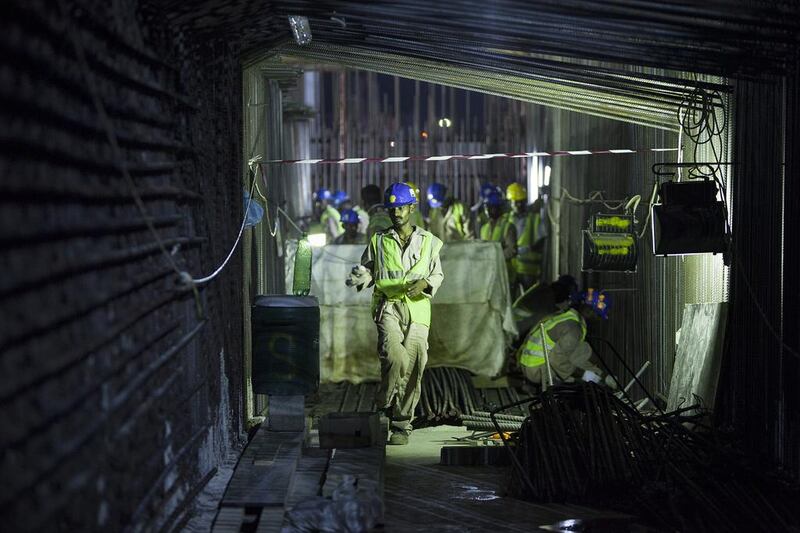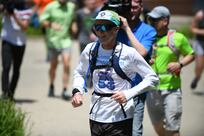It is 5.30 in the evening. Quiet conversation and the smell of aftershave fill the air as a stream of construction workers spills through the gate of the Saadiyat Island accommodation village and into the desert beyond.
Unbidden, the workers drill themselves into lines and wait for the flotilla of buses that will ferry them to their duties. For the Louvre Abu Dhabi's day shift ten hot hours are ending, but for the night shift, ten humid hours are about to begin.
What starts as a trickle of workers at the accommodation village turns into a torrent when the buses arrive at the Louvre Abu Dhabi construction site, 15 minutes away on the north-west tip of Saadiyat Island.
As the shifts change, about 3,000 workers "punch-out" and "punch-in", moving through a car park that soon fills with dust and a cacophony of voices, engine noise, whistles - blown by the yellow-hatted marshals who shepherd the crowds - and the insistent sirens of vehicles reversing.
By 6.30pm, twilight and an air of calm descends across the kilometre-wide site as the thousand-strong night shift prepares itself for the evening's labours.
A small group of worshippers assemble in the stark white beam of a floodlight to recite Maghrib, the sunset prayer, while others collect tools, protective clothing, and attend training sessions.
The momentary hiatus belies the fact that speed on the Louvre construction site is of the essence - the museum must be completed in just two years - and the problem that concrete, the material on which the project will literally stand or fall, can currently only be cast at night.
"This is such a fast-track project, it would be impossible to complete if we didn't have a night shift," explains Akhlaque Ahmed, a civil and structural inspector with Buro Happold, the engineers charged with designing and delivering the infrastructure for the new Louvre.
The reinforced concrete foundations, walls, floors, and ceilings not only provide support for the museum's more glamorous superstructure - Jean Nouvel's 180-metre-wide perforated space frame dome - but they must also provide an atmospherically secure environment without which the museum could not exist.
When the Louvre Abu Dhabi is complete, the treasures of its collection - including works by Manet, Picasso, Rembrandt, and Gaugin - will have to be move through a series of complex series of subterranean precincts before reaching the galleries where they will eventually go on display.
Parts of this basement are 7 metres below sea level, which makes the issue of the building's integrity a matter of the utmost importance.
Brian Cole, Buro Happold's director of engineering, explains the Louvre Abu Dhabi's particular dilemma: "We have interior and exterior conditions that are at opposite ends of the environmental scale. In the interior, we have to deliver the highest possible standards in terms of atmospheric conditions. We are dealing with museum facilities. Outside, we have the most adverse conditions. We have groundwater and the sea. That means we have to have very strict design parameters for the concrete."
To meet these exacting demands, the Louvre's engineers have devised a complex, multilayered system that includes a double layer of vacuum-sealed waterproof membranes, geotextiles, concrete screeds and an electrified system of "cathodic protection" designed to prevent potentially corrosive water from ever reaching the concrete's essential steel reinforcing rods.
If all of these systems failed, the Louvre's ultimate backup system is the solid concrete "raft" that extends across its entire lower surface. But if the raft has cracks in it, it is not only a basement but a whole museum that is thrown into doubt. Imperfect concrete represents an existential threat to the Louvre Abu Dhabi.
Unfortunately, during the summer, casting concrete with such perfection is all but impossible during the day, as Brian Cole explains.
"Casting at night improves the casting conditions. In the daytime, there's a real problem with the temperature of the reinforcing steels because they are in direct sunlight. They can reach 60 to 70 centigrade and that has an adverse effect on the bond between the concrete and the steel. The bonding of those two materials is essential for the performance of the reinforced concrete."
Higher temperatures not only increase the rate at which concrete dries, making it harder to work with, but also increase the likelihood of cracking, a problem that is also exacerbated by the concrete's ultimate strength. The stronger the concrete, the more heat it generates during the curing process and the resulting expansion and contraction of the mix also increases the likelihood of cracking.
Just like Goldilocks' porridge, the concrete at the Louvre must be just right - not too hot and not too cold, not too strong and not too weak.
Computers can now control the precise mix and ultimate strength of concrete but until temperatures in Abu Dhabi fall further, the best methods for ensuring the concrete's quality are night casting and a detailed system of inspection. That is where the diligence and the experience of engineers like Akhlaque Ahmed come in.
Mr Ahmed, originally from Mumbai, is one of three inspection engineers who work for Buro Happold on the night shift. His job is to inspect every detail of the construction process from the width of beams, to the size, number, placing and diameter of every steel reinforcing rod.
The key to Mr Ahmed's success as inspector lies, he insists, in balancing the non-negotiable need to comply with procedure with the ability to get along with his colleagues on site.
"It is important to have a good working relationship with everybody, so that we can achieve what we want in terms of quality. If you start shouting at people, you'll not get the quality you need. If you are polite and friendly, they'll listen to you and you'll get a quality job."
If even the slightest detail fails to comply with the design parameters set out on Mr Ahmed's construction drawings, he will not allow construction to proceed. Even small variations can have important repercussions. If the depth of a thin protective concrete screed exceeds the permitted 30mm, it can reduce the depth and therefore of the strength of the structural concrete eventually cast above it.
For just this reason, engineers like Mr Ahmed do not make random checks on the Louvre construction site, they check the details of every pour, something that is easier than it sounds when the restrictions placed on how much concrete and where it can be poured are taken into consideration.
On jobs where the quality of the concrete is of less of a consideration, pours of anything up to 2,000 to 2,500 square metres are possible, but at the Louvre Abu Dhabi, they are limited to only 400 square metres in a single cast. The speed of the Louvre's night time concrete construction programme is further hampered by the fact that a nine-day window must be left between adjacent pours. As the concrete cures, the reaction of water and cement creates heat and this results in expansion and contraction that must be allowed to subside before the next pour can begin.
The result is a construction timeline and a bewildering chequerboard pattern of casting from which it is impossible to deviate. The first castings are made at the "stiffest", most secure points in the structure of the Louvre's basement - the four enormous dome supports - before moving away in a complex patchwork pattern that is also determined by the nine-day rule.
If something goes wrong during a pour, a site engineer needs to respond immediately otherwise the whole process can be ruined and a delay on the first pour inevitably results in a delay on the last.
On the night shift at the Louvre Abu Dhabi, time is money and concrete waits for no man.
nleech@thenational.ae
Night shift at Louvre Abu Dhabi, where concrete reigns and pours
In order to meet its deadline, construction of the Louvre Abu Dhabi takes place all hours of the day and night. Nick Leech joins the night shift.

Editor's picks
More from the national





